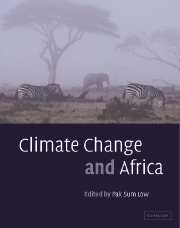Book contents
- Frontmatter
- Contents
- Notes on contributors
- Peer reviewers
- Editor's note
- Foreword
- Foreword
- Foreword
- Foreword
- Preface
- Preface
- Preface
- Preface
- List of abbreviations
- List of SI prefixes
- List of unit abbreviations
- List of chemical formulae
- Part I Science
- 1 Holocene climatic, hydrological and environmental oscillations in the tropics with special reference to Africa
- 2 The relative importance of the different forcings on the environment in Ethiopia during the Holocene
- 3 Global warming and African climate change: a reassessment
- 4 Interactions of desertification and climate in Africa
- 5 Africa's climate observed: perspectives on monitoring and management of floods, drought and desertification
- 6 Atmospheric chemistry in the tropics
- 7 Natural and human-induced biomass burning in Africa: an important source for volatile organic compounds in the troposphere
- 8 Biomass burning in Africa: role in atmospheric change and opportunities for emission mitigation
- 9 Soil micro-organisms as controllers of trace gas emissions over southern Africa
- Part II Sustainable energy development, mitigation and policy
- Part III Vulnerability and adaptation
- Part IV Capacity-building
- Part V Lessons from the Montreal Protocol
- Index
2 - The relative importance of the different forcings on the environment in Ethiopia during the Holocene
Published online by Cambridge University Press: 10 December 2009
- Frontmatter
- Contents
- Notes on contributors
- Peer reviewers
- Editor's note
- Foreword
- Foreword
- Foreword
- Foreword
- Preface
- Preface
- Preface
- Preface
- List of abbreviations
- List of SI prefixes
- List of unit abbreviations
- List of chemical formulae
- Part I Science
- 1 Holocene climatic, hydrological and environmental oscillations in the tropics with special reference to Africa
- 2 The relative importance of the different forcings on the environment in Ethiopia during the Holocene
- 3 Global warming and African climate change: a reassessment
- 4 Interactions of desertification and climate in Africa
- 5 Africa's climate observed: perspectives on monitoring and management of floods, drought and desertification
- 6 Atmospheric chemistry in the tropics
- 7 Natural and human-induced biomass burning in Africa: an important source for volatile organic compounds in the troposphere
- 8 Biomass burning in Africa: role in atmospheric change and opportunities for emission mitigation
- 9 Soil micro-organisms as controllers of trace gas emissions over southern Africa
- Part II Sustainable energy development, mitigation and policy
- Part III Vulnerability and adaptation
- Part IV Capacity-building
- Part V Lessons from the Montreal Protocol
- Index
Summary
Keywords
Ethiopia; Main Ethiopian Rift; Late Quaternary; Holocene environment; climate; volcanism; tectonics; human impact; crater lakes; palaeosoils; sediments; pollen; diatoms; radiocarbon dates; drought; rainfall variability; ENSO; deforestation; Little Ice Age
Abstarct
The environment within the Ethiopian region has been sensitive to different natural and anthropogenic factors on various timescales and during different times of the Quaternary. During the Holocene (the last 10, 000 years), the intensity of tectonics and volcanism in the Main Ethiopian Rift Valley has reduced, and their effects have been localized to marginal zones. However, climate change and variability on different timescales have been affecting the region within and outside the Rift Valley. During the twentieth century, the accelerated human impact has combined with highly variable rainfall, both on the inter-annual and inter-decadal timescales, to play a major role in limiting the availability of resources.
INTRODUCTION
Ethiopia is located in a geodynamically active zone and geographically sensitive area, Consequently, volcano-tectonism, as well as climate change and variability on different spatial and temporal scales, have affected its environment. Super-imposed on these, increasing human impact is modifying the land cover, land surface and hydrology. This chapter presents a review of the relative importance of the different environmental forcings during the Holocene (the last 10,000 years) in Ethiopia. This is a time when the major regional features of the environment, as we see them now, have been shaped.
- Type
- Chapter
- Information
- Climate Change and Africa , pp. 23 - 28Publisher: Cambridge University PressPrint publication year: 2005
- 1
- Cited by



